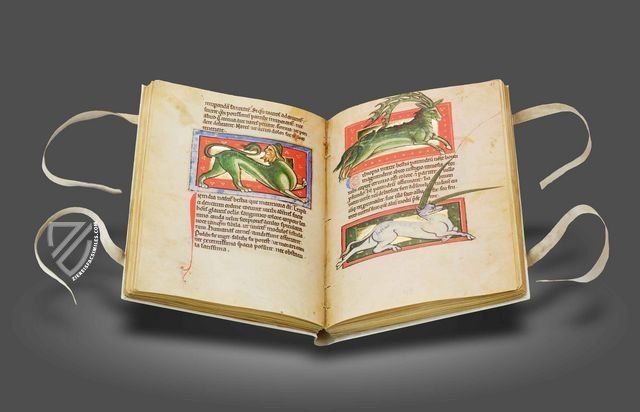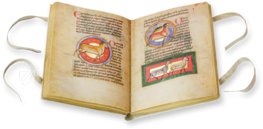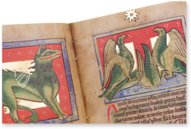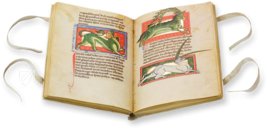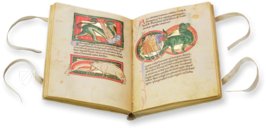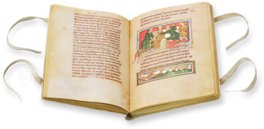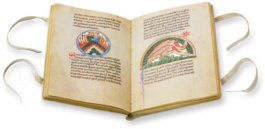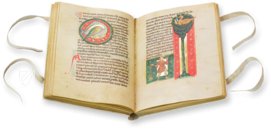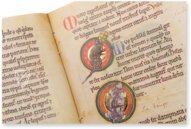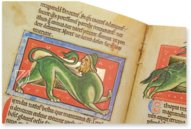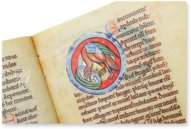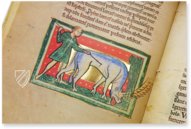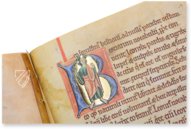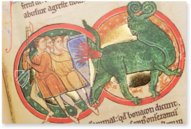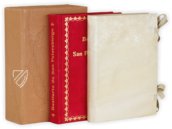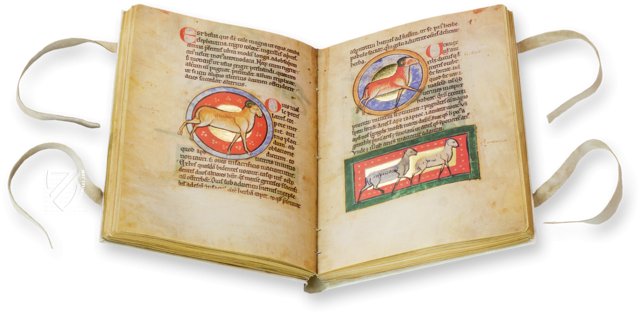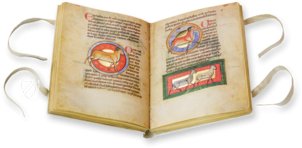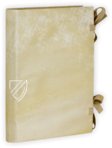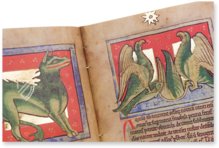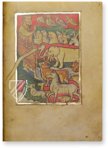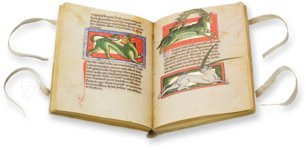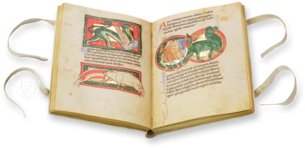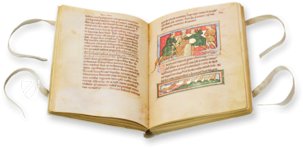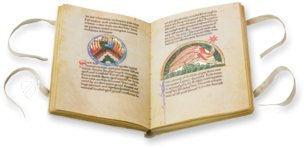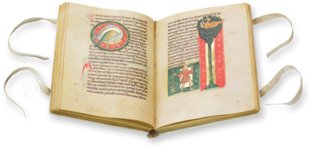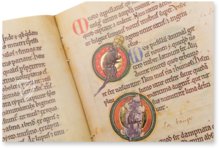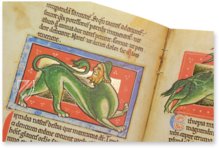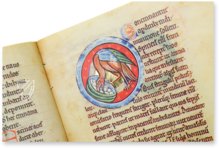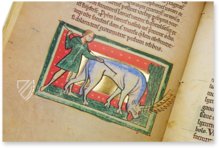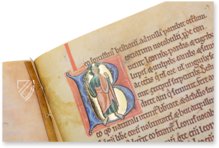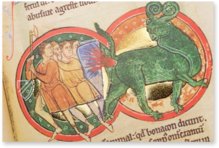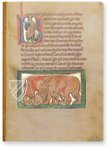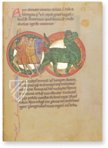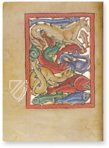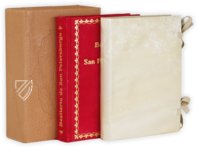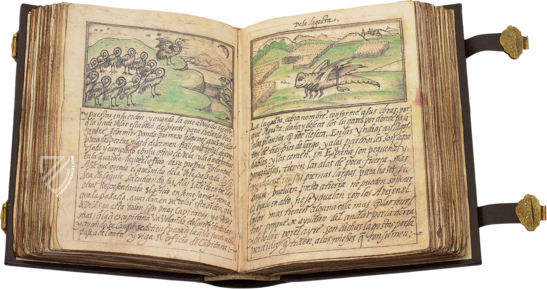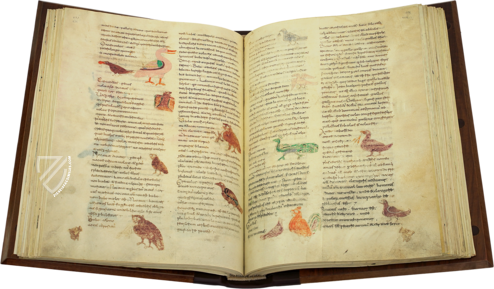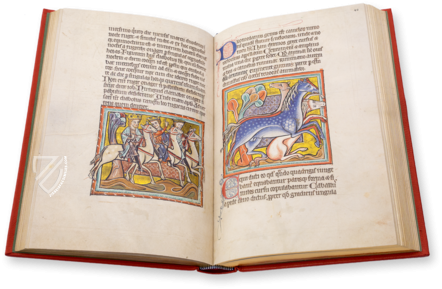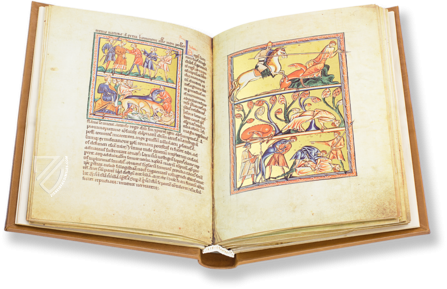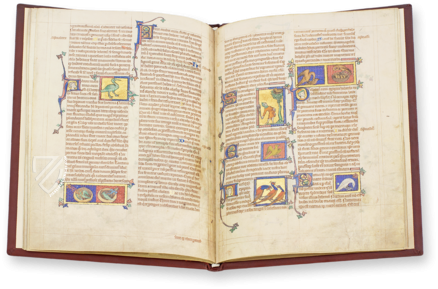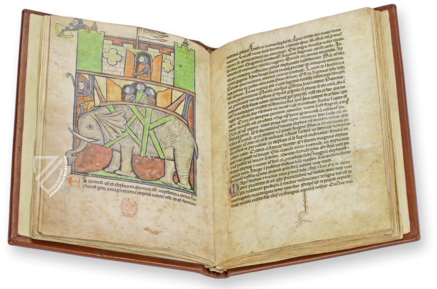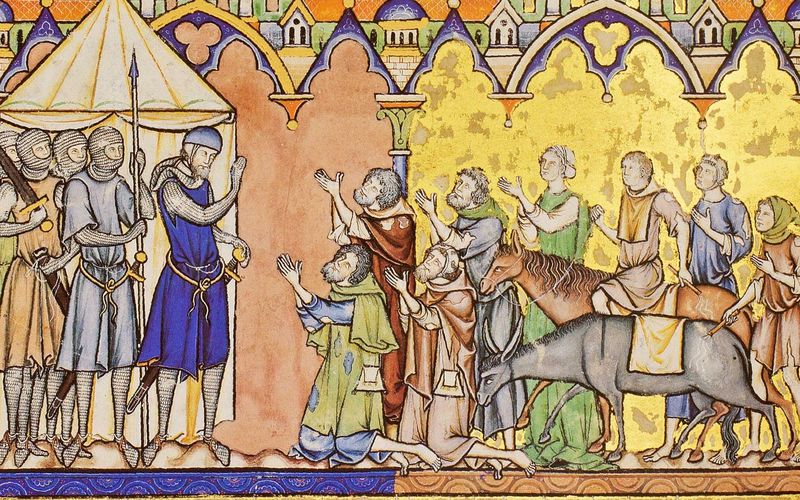St. Petersburg Bestiary
The literary genre of the bestiary is among the most beloved book genres of the medieval world. This is a particularly richly illuminated piece of animal literature, which moralistically described creatures from both the animal kingdom and the world of fantasy. These illuminated manuscripts were of especially high importance in 12th and 13th century England. The St. Petersburg Bestiary is one of the most beautiful and precious examples of these codices. It is decorated to an exceedingly rich degree with 114 colorful miniatures, most of which are set against a lofty gold leaf background, including 4 full-page miniatures. In addition to the depictions of animals, the work is furnished with an image cycle of the history of creation. Although clearly English in manufacture, little is known about the origins of the manuscript and even determining the source of its iconography is difficult. Nonetheless, it likely originated in a monastery in the northern Midlands ca. 1190.
St. Petersburg Bestiary
A bestiary is a type of medieval literature that allegorically connects moralized attributes, actual or supposed, of animals and mythical creatures, with the Christian doctrine of salvation. Bestiaries are among the most beloved manuscripts of the Middle Ages and were often richly illustrated. One of the most beautiful and most precious examples of this book genre is the St. Petersburg Bestiary. The work is furnished with a total of 114 fanciful, colored miniatures. Four of them take up a whole page and were set against an opulent gold background, as is nearly every picture in the manuscript. The manuscript was composed in England during the early 12th century and represents one of the first documents written in the Gothic style of illumination.
An International Codex
The liturgical genre of the bestiary was of great importance in 12th and 13th century England. Inquiries into the classification of its content and style have always been fraught with difficulties. The manuscript’s sites of origin are unknown or cannot be determined for certain, the source and iconography of the work are often unclear. The St. Petersburg Bestiary probably originated ca. 1190 in an English monastery in the northern Midlands. It found itself in France in the 15th and 16th centuries, which has been confirmed through numerous notes, mostly animal names in French. A note in Latin at the end of the text indicates an owner at the beginning of the 17th century: Francis de la Morlière. In the course of the centuries, the manuscript found itself in the library of Pierre Séguir, the director of the royal chancellery under two French kings, who possessed one of the most important book collections of his time. From there the codex reached the famous Parisian Saint-Germain-des-Près Abbey by way of inheritance. The manuscript came into the hands of its first Russian owner at the end of the 18th century. This was Peter Dumbrowsky, a diplomat and bibliophile whose name is immortalized in various inscriptions. In 1805, the work was incorporated with the rest of Dumbrowky’s library into the holdings of the then Imperial Library in St. Petersburg. Today, this is the Russian National Library.
A Luxurious Image Program
The St. Petersburg Bestiary was one of the first luxury bestiaries with miniature paintings in a precious gold leaf technique. In addition to the depictions of animals, the work is furnished with an image cycle of the history of creation. The miniatures of the bestiary were completed even before a scribe composed the text by hand. This is particularly noticeable in a few places, where it is clear that the lines of text had to avoid the pictorial scenes. The miniatures of the bestiary were created by at least two different illuminators. One of the artists concentrated on the design of the depictions of animals, while the other took care of the illustration of the creation cycle. A few special features can be recognized in the style of the illumination that make it possible to date the year to ca. 1190. The vivid alignment and the noble, harmonious coloration of the pictures attest to a painting style that recurred often in the English literature of this time. Particularly worthy of note is the design of the figures, above all the lines of the faces and the folds of the garments of those persons depicted. Instead of a flat painting style, the masters responsible for the bestiary were able to make their figures appear vivid and dynamic.
Codicology
- Alternative Titles
- Bestiario de San Petersburgo
Bestiarium aus St. Petersburg
Saltykov-Shchedrin Bestiary - Size / Format
- 182 pages / 21.0 × 14.5 cm
- Origin
- United Kingdom
- Date
- Late 12th century
- Epochs
- Style
- Genre
- Script
- Gothic Textura
- Illustrations
- 114 miniatures, 4 of which are full-page and most of them with gold backgrounds along with red and blue decorated initials
- Content
- Story of Creation based on the Book of Genesis; text on the naming of animals; Physiologus adaptation with excerpts from Isidore of Seville's Etymologiae
- Previous Owners
- Francis de la Morlière
Pierre Séguir
Saint–Germain–des–Près Abbey
Peter Petrovich Dubrovsky (1754–1816)
St. Petersburg Bestiary
Family of Lions
As the ‘king of the beasts’, the lion is the first animal featured in this splendid late-12th century English bestiary. The artist’s lack of familiarity with lions is evident from the fact that both parents are depicted with thick manes and he was likely working from a model, which was typical. Nonetheless, they are depicted with loving faces as they lick their cubs. The affectionate scene is presented in a simple green frame and presented in front of a burnished gold background.
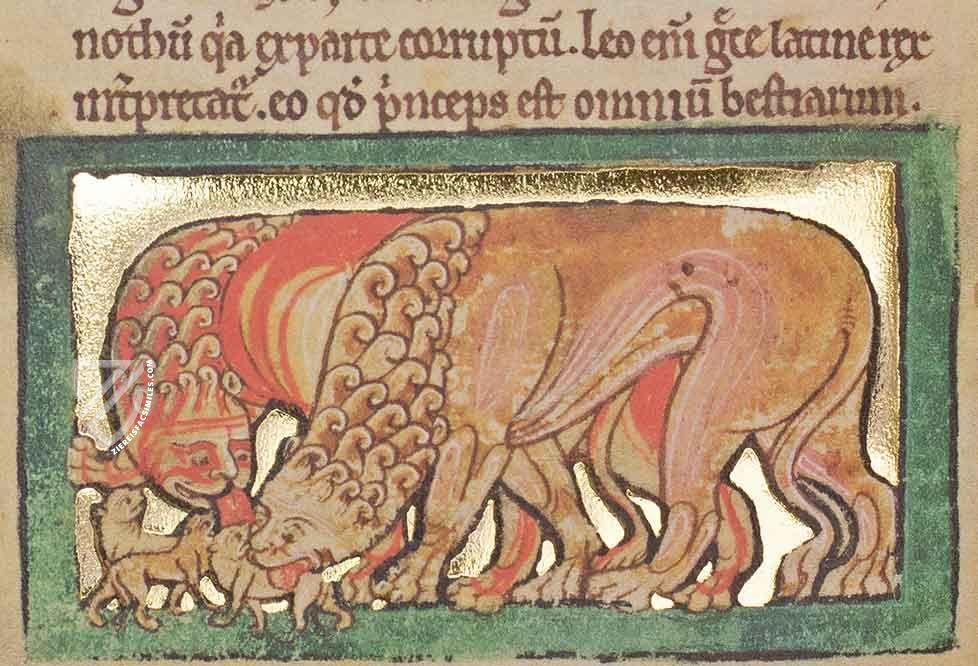
St. Petersburg Bestiary
The Bonnacon
Medieval bestiaries are beloved by bibliophiles for the often humorous depiction of creatures both real and imaginary. Few mythical beasts are as hilarious as the bonnacon, which was first described by Pliny the Elder, and protects itself from potential pursuers by using an unusual weapon – flaming flatulence.
The extremely high quality of this miniature – finely colored and contoured figures with a burnished gold leaf background – contrasts with its crude subject matter. Depicted in green, the bonnacon looks back at its pursuers and resembles a bull with inward-curving horns and a mane. We see the leading man protecting the rest of the group from the bonnacon’s “weapon” with a large blue kite shield as a man in the rear raises an axe.
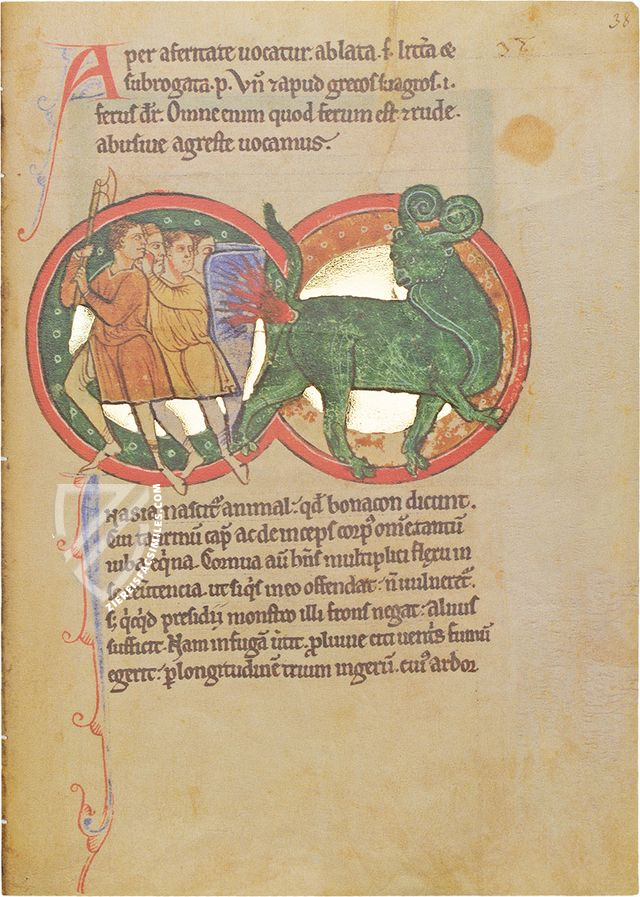
#1 Bestiario de San Petersburgo
Language: Spanish
- Treatises / Secular Books
- Apocalypses / Beatus
- Astronomy / Astrology
- Bestiaries
- Bibles / Gospels
- Chronicles / History / Law
- Geography / Maps
- Saints' Lives
- Islam / Oriental
- Judaism / Hebrew
- Single Leaf Collections
- Leonardo da Vinci
- Literature / Poetry
- Liturgical Manuscripts
- Medicine / Botany / Alchemy
- Music
- Mythology / Prophecies
- Psalters
- Other Religious Books
- Games / Hunting
- Private Devotion Books
- Other Genres
- Afghanistan
- Armenia
- Austria
- Belgium
- Belize
- Bosnia and Herzegovina
- China
- Colombia
- Costa Rica
- Croatia
- Cyprus
- Czech Republic
- Denmark
- Egypt
- El Salvador
- Ethiopia
- France
- Germany
- Greece
- Guatemala
- Honduras
- Hungary
- India
- Iran
- Iraq
- Israel
- Italy
- Japan
- Jordan
- Kazakhstan
- Kyrgyzstan
- Lebanon
- Liechtenstein
- Luxembourg
- Mexico
- Morocco
- Netherlands
- Palestine
- Panama
- Peru
- Poland
- Portugal
- Romania
- Russia
- Serbia
- Spain
- Sri Lanka
- Sweden
- Switzerland
- Syria
- Tajikistan
- Turkey
- Turkmenistan
- Ukraine
- United Kingdom
- United States
- Uzbekistan
- Vatican City
- A. Oosthoek, van Holkema & Warendorf
- Aboca Museum
- Ajuntament de Valencia
- Akademie Verlag
- Akademische Druck- u. Verlagsanstalt (ADEVA)
- Aldo Ausilio Editore - Bottega d’Erasmo
- Alecto Historical Editions
- Alkuin Verlag
- Almqvist & Wiksell
- Amilcare Pizzi
- Andreas & Andreas Verlagsbuchhandlung
- Archa 90
- Archiv Verlag
- Archivi Edizioni
- Arnold Verlag
- ARS
- Ars Magna
- ArtCodex
- AyN Ediciones
- Azimuth Editions
- Badenia Verlag
- Bärenreiter-Verlag
- Belser Verlag
- Belser Verlag / WK Wertkontor
- Benziger Verlag
- Bernardinum Wydawnictwo
- BiblioGemma
- Biblioteca Apostolica Vaticana (Vaticanstadt, Vaticanstadt)
- Bibliotheca Palatina Faksimile Verlag
- Bibliotheca Rara
- Boydell & Brewer
- Bramante Edizioni
- Bredius Genootschap
- Brepols Publishers
- British Library
- C. Weckesser
- Caixa Catalunya
- Canesi
- CAPSA, Ars Scriptoria
- Caratzas Brothers, Publishers
- Carus Verlag
- Casamassima Libri
- Centrum Cartographie Verlag GmbH
- Chavane Verlag
- Christian Brandstätter Verlag
- Circulo Cientifico
- Club Bibliófilo Versol
- Club du Livre
- CM Editores
- Collegium Graphicum
- Collezione Apocrifa Da Vinci
- Comissão Nacional para as Comemorações dos Descobrimentos Portugueses
- Coron Verlag
- Corvina
- CTHS
- D. S. Brewer
- Damon
- De Agostini/UTET
- De Nederlandsche Boekhandel
- De Schutter
- Deuschle & Stemmle
- Deutscher Verlag für Kunstwissenschaft
- DIAMM
- Droz
- E. Schreiber Graphische Kunstanstalten
- Ediciones Boreal
- Ediciones Grial
- Ediclube
- Edições Inapa
- Edilan
- Editalia
- Edition Deuschle
- Edition Georg Popp
- Edition Leipzig
- Edition Libri Illustri
- Editiones Reales Sitios S. L.
- Éditions de l'Oiseau Lyre
- Editions Medicina Rara
- Editorial Casariego
- Editorial Mintzoa
- Editrice Antenore
- Editrice Velar
- Edizioni Edison
- Egeria, S.L.
- Eikon Editores
- Electa
- Emery Walker Limited
- Enciclopèdia Catalana
- Eos-Verlag
- Ephesus Publishing
- Ernst Battenberg
- Eugrammia Press
- Extraordinary Editions
- Fackelverlag
- Facsimila Art & Edition
- Facsimile Editions Ltd.
- Facsimilia Art & Edition Ebert KG
- Faksimile Verlag
- Feuermann Verlag
- Folger Shakespeare Library
- Franco Cosimo Panini Editore
- Friedrich Wittig Verlag
- Fundación Hullera Vasco-Leonesa
- G. Braziller
- Gabriele Mazzotta Editore
- Gebr. Mann Verlag
- Gesellschaft für graphische Industrie
- Getty Research Institute
- Giovanni Domenico de Rossi
- Giunti Editore
- Graffiti
- Grafica European Center of Fine Arts
- Guido Pressler
- Guillermo Blazquez
- Gustav Kiepenheuer
- H. N. Abrams
- Harrassowitz
- Harvard University Press
- Helikon
- Hendrickson Publishers
- Henning Oppermann
- Herder Verlag
- Hes & De Graaf Publishers
- Hoepli
- Holbein-Verlag
- Houghton Library
- Hugo Schmidt Verlag
- Idion Verlag
- Il Bulino, edizioni d'arte
- ILte
- Imago
- Insel Verlag
- Insel-Verlag Anton Kippenberger
- Instituto de Estudios Altoaragoneses
- Instituto Nacional de Antropología e Historia
- Istituto dell'Enciclopedia Italiana - Treccani
- Istituto Ellenico di Studi Bizantini e Postbizantini
- Istituto Geografico De Agostini
- Istituto Poligrafico e Zecca dello Stato
- Italarte Art Establishments
- Jan Thorbecke Verlag
- Johnson Reprint Corporation
- Josef Stocker
- Josef Stocker-Schmid
- Jugoslavija
- Karl W. Hiersemann
- Kasper Straube
- Kaydeda Ediciones
- Kindler Verlag / Coron Verlag
- Kodansha International Ltd.
- Konrad Kölbl Verlag
- Kurt Wolff Verlag
- La Liberia dello Stato
- La Linea Editrice
- La Meta Editore
- Lambert Schneider
- Landeskreditbank Baden-Württemberg
- Leo S. Olschki
- Les Incunables
- Liber Artis
- Library of Congress
- Libreria Musicale Italiana
- Lichtdruck
- Lito Immagine Editore
- Lumen Artis
- Lund Humphries
- M. Moleiro Editor
- Maison des Sciences de l'homme et de la société de Poitiers
- Manuscriptum
- Martinus Nijhoff
- Maruzen-Yushodo Co. Ltd.
- MASA
- Massada Publishers
- McGraw-Hill
- Metropolitan Museum of Art
- Militos
- Millennium Liber
- Müller & Schindler
- Nahar - Stavit
- Nahar and Steimatzky
- National Library of Wales
- Neri Pozza
- Nova Charta
- Oceanum Verlag
- Odeon
- Orbis Mediaevalis
- Orbis Pictus
- Österreichische Staatsdruckerei
- Oxford University Press
- Pageant Books
- Parzellers Buchverlag
- Patrimonio Ediciones
- Pattloch Verlag
- PIAF
- Pieper Verlag
- Plon-Nourrit et cie
- Poligrafiche Bolis
- Presses Universitaires de Strasbourg
- Prestel Verlag
- Princeton University Press
- Prisma Verlag
- Priuli & Verlucca, editori
- Pro Sport Verlag
- Propyläen Verlag
- Pytheas Books
- Quaternio Verlag Luzern
- Reales Sitios
- Recht-Verlag
- Reichert Verlag
- Reichsdruckerei
- Reprint Verlag
- Riehn & Reusch
- Roberto Vattori Editore
- Rosenkilde and Bagger
- Roxburghe Club
- Salerno Editrice
- Saltellus Press
- Sandoz
- Sarajevo Svjetlost
- Schöck ArtPrint Kft.
- Schulsinger Brothers
- Scolar Press
- Scrinium
- Scripta Maneant
- Scriptorium
- Shazar
- Siloé, arte y bibliofilia
- SISMEL - Edizioni del Galluzzo
- Sociedad Mexicana de Antropología
- Société des Bibliophiles & Iconophiles de Belgique
- Soncin Publishing
- Sorli Ediciones
- Stainer and Bell
- Studer
- Styria Verlag
- Sumptibus Pragopress
- Szegedi Tudomànyegyetem
- Taberna Libraria
- Tarshish Books
- Taschen
- Tempus Libri
- Testimonio Compañía Editorial
- Thames and Hudson
- The Clear Vue Publishing Partnership Limited
- The Facsimile Codex
- The Folio Society
- The Marquess of Normanby
- The Richard III and Yorkist History Trust
- Tip.Le.Co
- TouchArt
- TREC Publishing House
- TRI Publishing Co.
- Trident Editore
- Tuliba Collection
- Typis Regiae Officinae Polygraphicae
- Union Verlag Berlin
- Universidad de Granada
- University of California Press
- University of Chicago Press
- Urs Graf
- Vallecchi
- Van Wijnen
- VCH, Acta Humaniora
- VDI Verlag
- VEB Deutscher Verlag für Musik
- Verlag Anton Pustet / Andreas Verlag
- Verlag Bibliophile Drucke Josef Stocker
- Verlag der Münchner Drucke
- Verlag für Regionalgeschichte
- Verlag Styria
- Vicent Garcia Editores
- W. Turnowski Ltd.
- W. Turnowsky
- Waanders Printers
- Wiener Mechitharisten-Congregation (Wien, Österreich)
- Wissenschaftliche Buchgesellschaft
- Wissenschaftliche Verlagsgesellschaft
- Wydawnictwo Dolnoslaskie
- Xuntanza Editorial
- Zakład Narodowy
- Zollikofer AG

